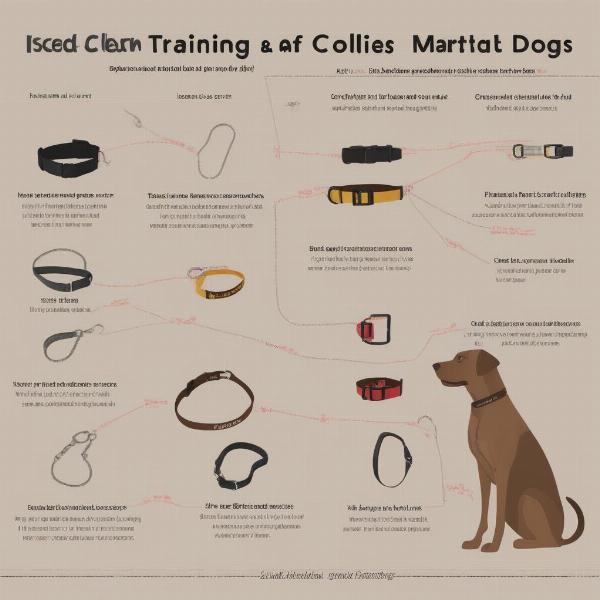Training collars can be a valuable tool for managing and training large dog breeds, but choosing the right one and using it correctly is crucial. This guide explores the different types of training collars available for large dogs, helping you make an informed decision based on your dog’s needs and training goals. We’ll cover everything from proper fitting and usage techniques to addressing common concerns and ensuring a positive training experience for both you and your furry friend.
Understanding Training Collars for Large Dogs
 Types of Training Collars for Large Dogs
Types of Training Collars for Large Dogs
Large dog breeds often require specialized training tools due to their size and strength. A training collar, when used responsibly, can assist in teaching obedience, correcting unwanted behaviors, and ensuring safety. It’s essential to remember that a training collar is not a punishment device but a communication tool to guide your dog towards desired behaviors. Choosing the wrong collar or using it improperly can be detrimental to your dog’s well-being.
Types of Training Collars for Large Dogs
There are several types of training collars suitable for large dogs, each with its advantages and disadvantages:
- Flat Collars: The most basic type, ideal for everyday use and attaching identification tags. Not typically recommended for training strong pullers.
- Martingale Collars: A good choice for dogs who slip out of flat collars. They tighten when the dog pulls, but not to the point of choking.
- Prong Collars: Also known as pinch collars, these should only be used under the guidance of a professional trainer. They apply pressure evenly around the neck when the dog pulls.
- Slip Leads: A simple loop of material that tightens when the dog pulls. Can be effective for training but requires careful handling to avoid choking.
- Head Halters: Similar to a horse halter, these gently redirect the dog’s head and can be beneficial for controlling pulling.
What type of collar is best for a large dog that pulls?
For large dogs that pull, a martingale collar, head halter, or a front-clip harness can be effective. german shepherd mix dogs often benefit from these types of collars. Consult with a professional trainer to determine the most suitable option for your dog’s specific needs and temperament.
Fitting and Using a Training Collar Correctly
Proper fit and usage are crucial for any training collar. A collar that’s too tight can cause discomfort and injury, while one that’s too loose can be ineffective or even dangerous.
- Measure your dog’s neck: Use a measuring tape to determine the correct size.
- Allow for two fingers: You should be able to fit two fingers comfortably between the collar and your dog’s neck.
- Introduce the collar gradually: Allow your dog to get used to the collar before using it for training.
- Use positive reinforcement: Combine the use of the training collar with positive reinforcement techniques, such as treats and praise.
- Seek professional guidance: If you’re unsure about how to use a specific type of collar, consult with a certified dog trainer.
Common Concerns and Misconceptions
Some common concerns about training collars include the potential for choking or causing pain. When used correctly and fitted properly, training collars should not cause harm. It’s important to avoid using aversive methods that rely on pain or discomfort. Positive reinforcement methods are always more effective and humane. dog collars for xl dogs can be particularly challenging to fit, so seeking professional advice is important.
Conclusion
Training collars can be valuable tools for managing and training large dogs when used responsibly and humanely. Understanding the different types available, choosing the right fit, and employing positive reinforcement techniques are essential for a successful training experience. Remember, a training collar is a communication aid, not a punishment device. By prioritizing your dog’s well-being and seeking professional guidance when needed, you can effectively use training collars to strengthen your bond and achieve your training goals. bark collar for small dogs under 5 lbs may not be suitable for large breeds. x large dog harness can be a good alternative for some dogs.
FAQ
- Are prong collars safe for large dogs? Prong collars should only be used under the guidance of a professional trainer.
- What’s the best training collar for a dog that pulls? Martingale collars, head halters, or front-clip harnesses can be effective for dogs that pull. dog at large situations can be prevented with proper training and the right equipment.
- How tight should a training collar be? You should be able to fit two fingers comfortably between the collar and your dog’s neck.
- Can I use a training collar on a puppy? It’s best to consult with a veterinarian or trainer before using a training collar on a puppy.
- What are some alternatives to training collars? Harnesses and head halters are popular alternatives.
- How do I introduce a training collar to my dog? Introduce the collar gradually and pair it with positive reinforcement.
- Where can I find a certified dog trainer? You can search online for certified dog trainers in your area.
ILM Dog is a leading international online resource dedicated to providing expert advice and information on dog care, breeds, training, health, nutrition, and much more. We are passionate about helping dog owners worldwide provide the best possible care for their canine companions. Whether you’re a seasoned dog owner or just starting your journey, ILM Dog offers a wealth of knowledge to support you every step of the way. Contact us at [email protected] or +44 20-3965-8624 for any inquiries. Visit us at ILM Dog for more valuable resources and expert guidance.